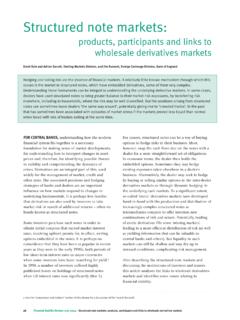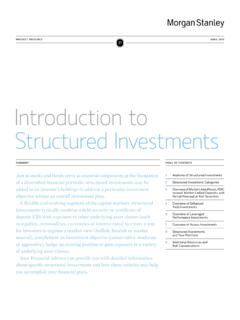Transcription of Outlook for the Securitisation Market (Blommestein et al)
1 1 * * The authors are working in the Bond Market and Public Debt Management Unit in the Financial Affairs Division of the OECD Directorate for Financial and Enterprise Affairs, as Head of the Unit, Sovereign Debt Market Expert (on leave from the Turkish Treasury) and Public Debt Management Consultant, respectively. This article was initially prepared as a background note for the Twelfth OECD-WBG-IMF Global Bond Market Forum, held in Paris May 5-6, 2011, on the topic of The Future of Debt Markets . This work is published on the responsibility of the Secretary-General of the OECD. The opinions expressed and arguments employed herein are those of the authors and do not necessarily reflect the official views of the Organisation or of the governments of its member countries.
2 2 OECD JOURNAL: FINANCIAL Market TRENDS VOLUME 2011 ISSUE 1 OECD 2011 I. Introduction to structured-finance securitisation1 The US subprime Securitisation Market was a catalyst for the global credit crisis The US subprime-cum- Securitisation crisis was a key catalyst for the global liquidity crisis that mutated into a full-blown credit crisis, bringing the international financial system to the edge of the abyss2. In hindsight, the numerous structural shortcomings of the structured- finance Securitisation Market - particularly in the US - may have seemed obvious. The misalignment of incentives was evident in every link along the structured-finance Securitisation chain. Proper risk evaluation was not always undertaken by professional investors and intermediaries, while too much faith was put in credit rating agencies whose own methodologies for valuing complex structured finance products were at times flawed.
3 In addition, other gatekeepers of the public trust including auditors, securities lawyers, regulators and supervisors failed, to varying degrees. Securitisation provides benefits to both issuers and investors Securitisation has traditionally offered banks with a key source of long-term funding, and thereby allowed for improved balance sheet management. It has been credited with increasing the availability of credit, while decreasing its cost. Investors also benefit from Securitisation by gaining direct risk exposure to diversified sectors of the economy. More generally, the key benefit of structured finance Securitisation was said to be the ability to disperse and redistribute credit risk to a broader and more diverse investor base.
4 Yet risk concentration increased; and the Market became illiquid at the first signs of financial stress Ironically, risk concentration turned out to have risen sharply, and was a key contributor to the widespread banking sector losses witnessed during the global financial crisis. In the run-up to the financial crisis, banks were allowed to significantly leverage up their balance sheets with limited disclosure, concentrating both their investment and funding needs in an asset class that proved to be illiquid at the first signs of financial stress. Financial stability was also weakened because Securitisation led in several instances to a lowering of banking standards3. A number of new structured products became overly complex and opaque, while risks were seriously underpriced4.
5 The considerable size of the Securitisation markets made them an important factor in the global liquidity-cum-credit crisis . The European Securitisation Market did not suffer to the same extent as the US However, it is important to note that not all structured-finance Securitisation was as unsound as was the case in the US subprime mortgage sector5, which by itself represented less than 10% of all US securitised mortgages. Securitisation acted primarily as a legitimate funding tool in Europe, as opposed to Securitisation being an end in itself for capital arbitrage reasons as was often the case in the US. Moreover, there was much less disengagement by European underwriters (and hence, more skin in the game ) than by their US colleagues, and regulation and underwriting standards were seen to be significantly more robust in Europe.
6 It was never really a credit story for the European OECD JOURNAL: FINANCIAL Market TRENDS VOLUME 2011 ISSUE 1 OECD 2011 3 Securitisation Market , but one of investors taking mark-to- Market losses as Securitisation markets became illiquid and prices fell. A survey conducted by Bishopsfield Capital Partners in June 2010 revealed that 73% of investors believed losses were attributed to Market re-pricing rather than actual credit In addition, 65% of respondents agreed that Securitisation as a general investment type had truly been damaged by the credit crisis. There s no doubt that the Securitisation asset class in general was tarnished by the fallout from the US subprime crisis. Structured- finance default rates were considerably lower in Europe However, in Europe this under-pricing mainly reflected liquidity risks, while credit risk was often properly priced.
7 For the most part, collateral performance has remained strong in the past few years. Indeed, the resilience of the European structured-finance Market can be evidenced in the post-crisis default data compiled by rating agencies such as Standard & Poor s. From mid-2007 to the end of 2010, only of all European structured-finance issues defaulted, compared to of US structured-finance issues, and among the universe of global corporate bonds (Table 1). Table 1. European structured-finance default rates (mid-2007 to Q4 2010)* ABS Structured Credit CMBS RMBS All European All US structured finance* All Corporate** *by initial issuance volume ** by number of ratings Source: Standard & Poor s. The Securitisation Market is expected to recover in the longer term In the wake of the crisis, structured-finance Securitisation issuance has dropped sharply.
8 Key segments of the Market continue to rely on government-backed liquidity and asset purchase programs. Yet despite the aforementioned structural shortcomings, it seems likely that in the long run, structured-finance Securitisation will once again become an important channel for debt markets; in the shorter term, Securitisation may even rebound to support the global economic recovery, provided certain important pre-conditions are in place. But faces a number of threats in the short term This article identifies key threats to these pre-conditions, which in turn could inhibit or delay a recovery in structured-finance Securitisation To that end, the article will assess the recovery of Securitisation from the perspective of funding costs, regulatory reform, and investor demand.
9 At the same time, however, it is likely that the structure of Securitisation products may differ from those in the past. For example, products may be simpler in structure, offering more transparency and a 4 OECD JOURNAL: FINANCIAL Market TRENDS VOLUME 2011 ISSUE 1 OECD 2011 higher quality of collateral than before the credit crisis8. As such, this article will assess investor demand in the context of tested single-layer structures, improved disclosure, and heightened regulation. II. Securitisation issuance levels Issuance levels slumped following the global financial crisis Prior to the global financial crisis, benign economic and financial conditions fuelled an explosion in global Securitisation issuance, peaking at around USD4 trillion in 2006.
10 Following the crisis, issuance of private-label Securitisation slumped. Although there have been some signs of a re-emergence in European issuance in 2010, key segments of the Securitisation Market continue to rely on support from the ECB s liquidity program, and is aptly named retained9 issuance (Figure 1). Figure 1. European Securitisation issuance 2002-2010, EUR bn 0200400600800020304050607080910 RetainedPlaced02004006008000203040506070 80910 RetainedPlaced RMBS CMBSABSCDO Source: AFME (Association for Financial Markets in Europe). Placed issuance is beginning to slowly recover in Europe European placed issuance totalled EUR88 billion in 2010, made up largely of UK and Dutch prime RMBS (residential mortgage-backed securities). While this figure was a marked improvement on the EUR25 billion of placed issuance recorded in 2009, it fell significantly short of the EUR460 billion of placed issuance seen at the height of the Market in 2006.
















